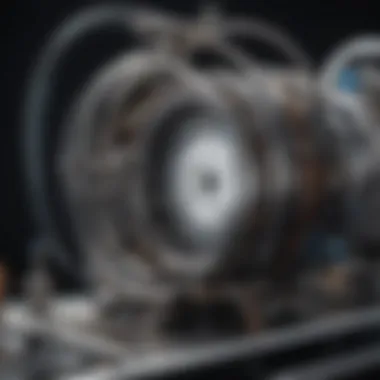Gas Chromatography and TOF-MS: Insights and Applications


Intro
Gas chromatography (GC) and time-of-flight mass spectrometry (TOF-MS) are two pillars of analytical chemistry, playing critical roles in various fields including pharmaceuticals, environmental studies, and food safety. Their interaction creates a powerful analytical toolset that maximizes the strengths of each method. This article aims to dissect the collaborative functionalities of GC and TOF-MS, exploring their principles, advantages, and comprehensive applications.
This exploration will reveal how these methodologies can provide enhanced accuracy and efficiency in chemical analysis. As industries and research evolve, understanding these technologies will be crucial for professionals, educators, and students alike.
Finally, the implications of advancements in GC and TOF-MS will be examined, providing a forward-looking perspective on the future of chemical analysis.
Key Findings
Gas chromatography, known for its ability to separate volatile compounds, works efficiently by vaporizing samples and separating them through a column. As the separated components exit the column, they are detected by TOF-MS. This process not only identifies the components but also provides detailed information about their molecular weights.
Major Results
When GC and TOF-MS are combined, several significant outcomes have been noted:
- Enhanced sensitivity and specificity in detection.
- Ability to analyze complex mixtures effectively.
- Reduction in analysis time, allowing for high-throughput applications.
These results underline the importance of integrating these two methodologies to achieve superior analytical capabilities.
Discussion of Findings
The findings from this interplay suggest that combining GC and TOF-MS opens up unique possibilities for research. Researchers have reported increased accuracy in detecting trace levels of contaminants in various matrices. For instance, in environmental applications, this synergy enables the detection of pollutants at lower thresholds, providing better insight into environmental health.
Furthermore, the pharmaceutical industry benefits from these advancements through improved identification of compounds during drug development stages. The precise characterization of compounds can lead to more effective treatments and formulations.
Methodology
An investigation into the interplay of GC and TOF-MS involves several key steps, focusing on research design and data collection methods.
Research Design
The methodology generally includes a comparative analysis of traditional methods versus the integrated approach of GC and TOF-MS. This involves designing experiments that demonstrate the efficacy of combining the two technologies, often focusing on specific applications in real-world scenarios such as toxicology, forensics, and metabolic profiling.
Data Collection Methods
Data is typically collected through a series of defined protocols:
- Conducting controlled experiments to separate and identify compounds.
- Utilizing statistical tools to assess the robustness of the data acquired from both GC and TOF-MS.
- Evaluating the performance of the integrated system against existing methods in terms of accuracy, sensitivity, and reproducibility.
For further insights on gas chromatography, consider referencing Wikipedia or Britannica.
The integration of gas chromatography and time-of-flight mass spectrometry is not merely additive. It optimally enhances the analytical capabilities of chemical analysis, leading to advancements in multiple domains.
Intro to Gas Chromatography and Time-of-Flight Mass Spectrometry
In the realm of analytical chemistry, gas chromatography (GC) and time-of-flight mass spectrometry (TOF-MS) are two powerful techniques often utilized for their unique attributes and complementary nature. Their integration allows researchers to achieve a higher level of accuracy and deeper insights than using either method in isolation. Understanding both GC and TOF-MS is essential for students, researchers, and professionals who are looking to enhance their analytical capabilities.
Gas chromatography serves as a critical method for separating volatile compounds in a mixture. This separation facilitates the identification and quantification of those compounds. The precision of GC makes it invaluable in various fields, such as environmental monitoring, pharmaceuticals, and food safety.
On the other hand, TOF-MS provides detailed mass analysis of the separated components, enabling the determination of molecular weights and structural information. This combination allows for a thorough analysis of complex mixtures, making it an indispensable tool in many laboratories.
Understanding the interplay between GC and TOF-MS is crucial for developing more efficient analytical protocols. It opens new avenues for research and application, as the synergy of these techniques can lead to improved data quality and higher throughput.
"The combination of gas chromatography and time-of-flight mass spectrometry is a prime example of how different analytical techniques can work together to enhance the understanding of complex chemical systems."
Overview of Analytical Techniques
Analytical techniques play a pivotal role in modern science. Gas chromatography and time-of-flight mass spectrometry are among the most prominent methods, each contributing specific strengths to analytical workflows.
- Gas Chromatography is based on the principle of separating components in a volatile mixture using an inert gas as a carrier. Its major advantages include high resolution, speed, and the ability to analyze complex matrices.
- Time-of-Flight Mass Spectrometry is a technique used to measure the mass-to-charge ratio of ions. The TOF analysis allows for the separation of ions based on their velocities, providing significant detail about molecular weights and structures.


These techniques serve as foundational tools in research and industrial applications, enabling scientists and professionals to derive meaningful insights from their analytical efforts.
Historical Development of GC and TOF-MS
The progression of gas chromatography and time-of-flight mass spectrometry reflects significant advancements in analytical chemistry over the last few decades.
- Gas Chromatography began in the 1950s with the work of scientists like Archer John Porter Martin and Richard Laurence Millington Synge, who are credited with its development based on partition chromatography. The introduction of packed columns, and later capillary columns, greatly improved the sensitivity and efficiency of the technique.
- Time-of-Flight Mass Spectrometry developed later, gaining prominence in the late 20th century. The implementation of TOF analyzers became feasible with advancements in electronics and data processing, which enabled detailed mass analysis and rapid data acquisition.
Understanding the history behind these techniques gives context to their current applications and capabilities, underscoring the importance of ongoing innovation in the field of analytical chemistry.
Fundamentals of Gas Chromatography
In this section, we outline the essential principles and components that form the foundation of gas chromatography, often referred to as GC. Understanding these fundamentals is critical, as they dictate how effectively substances are analyzed in various applications. Gas chromatography is renowned for its ability to separate and quantify volatile compounds in a mixture. This capability makes it invaluable in fields ranging from environmental monitoring to pharmaceuticals. A solid grasp of GC allows researchers to design experiments that yield reliable and reproducible results.
Principles of Gas Chromatography
Gas chromatography operates on the principle of partitioning compounds between a stationary phase and a mobile gas phase. The sample is vaporized and carried by an inert gas, typically helium or nitrogen, through a column packed with the stationary phase. As compounds traverse the column, their differing affinity for the stationary phase results in separation. The time taken for each compound to elute from the column is known as the retention time and is crucial for the identification of substances.
Key Components of GC Systems
A gas chromatography system consists of several key components that contribute to its effectiveness. Understanding these elements is beneficial for optimizing analysis.
Injection Systems
The injection system is the gateway for the sample into the chromatograph. It is responsible for introducing a precise volume of the sample vapor into the carrier gas stream. A popular choice is the autosampler, which can improve reproducibility and efficiency in high-throughput applications. A unique feature of modern injection systems is their ability to handle both small and large volumes, catering to diverse analytical needs. The precision offered by these systems is critical for achieving consistent results.
Columns
Columns are essential for the separation process in gas chromatography. They are typically made of either glass or metal and packed or coated with a stationary phase. Their ability to influence separation efficiency is notable. Popular stationary phases vary, enabling the analysis of a broad range of compounds. However, the choice of a column can affect analysis time and resolution. For instance, a shorter column may reduce runtime but can lead to compromised separation quality.
Detectors
Detectors play a pivotal role in identifying and quantifying the separated compounds as they elute from the column. Common detectors include flame ionization detectors (FID) and mass spectrometric detectors (MS). FID is a widely used choice due to its sensitivity and simplicity, making it suitable for organic compounds. However, it may not respond to all analytes. Mass spectrometric detectors, on the other hand, provide structural information, enhancing the ability to identify unknown compounds but may be more complex to operate.
GC Methods and Techniques
Understanding various methods and techniques is essential for enhancing the efficiency and accuracy of gas chromatography.
Split and Splitless Injection
This technique influences how sample components enter the column. In split injection, only a fraction of the vaporized sample is introduced, useful for high-concentration samples. Conversely, in splitless injection, the entire vapor sample is introduced, beneficial for trace analysis. The unique advantage of splitless injection lies in its ability to detect low concentration substances but can lead to increased background noise if not managed properly.
Temperature Programming
Temperature programming involves altering the temperature of the column during analysis to improve separation efficiency. It enables volatile compounds to elute at their appropriate times, reducing peak broadening. This technique is favored for complex mixtures where a single temperature could hinder quality. The disadvantage, however, is that it may require careful calibration and can extend analysis time if not optimized.
Principles of Time-of-Flight Mass Spectrometry
Time-of-flight mass spectrometry (TOF-MS) represents a crucial advancement in analytical chemistry. By providing rapid and highly accurate mass analysis, it complements other analytical techniques effectively. Its significance stems from its ability to measure the mass-to-charge ratio of ions, which aids in the identification and quantification of various substances in complex mixtures. In this section, we dissect the fundamental components and mechanisms of TOF-MS, ultimately illuminating its advantages in the realm of analytical applications.
Understanding Mass Spectrometry
Mass spectrometry is a technique widely employed to determine the composition of substances. By converting molecules into ions, it allows them to be analyzed based on their mass-to-charge ratios. This process begins with ionization, where particles become charged, allowing them to be manipulated by electric and magnetic fields. Understanding the principles of mass spectrometry is essential for grasping TOF-MS, as TOF is essentially a subclass of mass spectrometry aimed at enhancing resolution and speed of analysis.
Mechanisms of TOF Analysis
The TOF mass spectrometer operates on a straightforward yet effective mechanism. Once ions are generated, they are accelerated by an electric field, moving into a field-free region. After this, they travel through a drift tube. The time taken by each ion to reach the detector is measured and directly correlates to its mass-to-charge ratio. Lighter ions travel faster than heavier ones. In this way, TOF analysis ensures rapid and precise results, making it highly favorable in various applications like proteomics and environmental monitoring.
Important Components of TOF-MS
Ionization Techniques


Ionization techniques are critical as they initiate the mass spectrometry process. Common methods include Electron Impact (EI), Electrospray Ionization (ESI), and Matrix-Assisted Laser Desorption/Ionization (MALDI). Each technique has distinct characteristics making them suitable for different applications. For instance, Electrospray Ionization is a beneficial choice for biological samples due to its soft ionization process, preserving the molecular integrity during analysis. However, it may not be as effective for volatile compounds compared to other methods.
Flight Tubes
Flight tubes are integral components of TOF-MS, serving as the pathway for ions to travel from the ionization source to the detector. The length of the flight tube can influence resolution; longer tubes tend to yield better mass resolution as ions have more time to separate based on their mass. However, longer tubes also require more space and may increase the overall size of the instrument, which can be a consideration in laboratory setups.
Detectors
Detectors in TOF-MS are responsible for recording the arrival times of ions. Common types include Microchannel Plates (MCP) and Time-Delay Integration (TDI) detectors. MCPs are favored for their rapid response and high sensitivity, allowing for the detection of even low-abundance ions. However, their performance may vary under different experimental conditions. The choice of detector largely impacts the efficiency and effectiveness of TOF analysis, making it a pivotal aspect of instrument design.
Integration of GC and TOF-MS
The integration of gas chromatography (GC) and time-of-flight mass spectrometry (TOF-MS) marks a noteworthy advancement in analytical chemistry. This synergy enhances the capability to identify and quantify complex mixtures of compounds with high precision and speed. The ability of GC to efficiently separate volatile components in mixtures complements the mass spectrometric analysis offered by TOF-MS, resulting in more comprehensive analytical outcomes. This section highlights specific benefits and considerations related to the integration of these two methodologies.
Enhancing Analysis with Combined Techniques
When gas chromatography is coupled with time-of-flight mass spectrometry, the resulting technique provides a robust platform for various applications. The GC component excels at separating complex mixtures based on the volatility and affinity of different compounds toward the column, while TOF-MS delivers detailed mass information.
- Increased Sensitivity: The combination significantly increases the sensitivity of analyte detection, allowing for the analysis of trace levels within complex matrices.
- Comprehensive Identification: By capturing precise mass information, this integrated approach enables accurate identification of compounds, even those present in low concentrations.
- Faster Analysis: The coupling reduces the time required for sample analysis by streamlining sample processing and providing rapid detection capabilities.
- Greater Accuracy: The reduction in potential errors from manual analysis or separate techniques leads to more reliable results.
Researchers and professionals in the field have noted that the enhanced capabilities of the combined techniques provide critical advantages in various areas such as environmental monitoring, food safety, and pharmaceuticals.
Data Acquisition and Interpretation
Data acquisition methods in GC-TOF-MS systems are generally automated, capturing mass spectra during the elution of compounds from the GC column. The interpretation of this data is paramount for deriving meaningful insights from the results.
- Automated Data Processing: Modern instruments often include sophisticated software that automates data acquisition and processing, which saves time and reduces the chance for human error.
- Software Tools: Many contemporary tools facilitate the interpretation of mass spectra, allowing users to identify compounds based on mass-to-charge ratios and abundance. These tools often come with databases that assist in matching observed spectra with known compounds.
- Statistical Analysis: Applying statistical methods helps in validating results and understanding variability. For instance, multivariate analysis can explore relationships in complex datasets, improving the interpretative accuracy.
The integration of GC and TOF-MS not only refines analytical processes but also enhances the overall understanding of chemical compositions in diverse applications.
Applications in Various Fields
The combination of gas chromatography (GC) and time-of-flight mass spectrometry (TOF-MS) has changed various fields of analytical chemistry. By analyzing complex samples with precision, the synergy between these two techniques is particularly useful across diverse sectors such as environmental science, pharmaceuticals, and food safety. The use of GC-TOF-MS allows for the detailed identification and quantification of compounds, which is essential for maintaining standards and ensuring safety. With rising environmental concerns and regulatory issues, the importance of effective analysis methods in these fields continues to grow.
Environmental Analysis
Environmental analysis uses GC-TOF-MS for monitoring pollutants and assessing the health of ecosystems. Techniques are employed to detect trace levels of harmful substances in air, water, and soil, which is vital for public health and environmental protection. Sensitive detection capabilities enable researchers to identify contaminants like pesticides, heavy metals, or volatile organic compounds.
Key considerations include:
- Regulatory Compliance: Many countries have strict regulations regarding pollutants. GC-TOF-MS helps laboratories to adhere to these standards.
- Public Health: Early detection of environmental risks can prevent health issues.
- Ecosystem Studies: Analysis aids in understanding the impact of pollutants on wildlife.
In summary, GC-TOF-MS plays a crucial role in identifying and quantifying environmental pollutants, contributing to informed decision-making.
Pharmaceutical and Biomedical Applications
In the pharmaceutical realm, GC-TOF-MS is utilized for drug development and monitoring. This technique is crucial for analyzing active pharmaceutical ingredients and ensuring that formulations meet safety standards. The ability to separate and identify compounds efficiently aids researchers in understanding drug composition and efficacy.
Important aspects include:
- Drug Discovery: During the development stage, analyzing chemical structures is essential for formulating new drugs.
- Quality Control: Regular testing for impurities and degradation products ensures the integrity of pharmaceutical products.
- Clinical Research: It supports the biomarker discovery process, proving valuable in personalized medicine.
The high sensitivity and precision of GC-TOF-MS foster advancements in pharmaceutical applications, offering insights that enhance patient outcomes.
Food Safety and Quality Control
The food industry relies heavily on GC-TOF-MS for ensuring food safety and quality control. The technique is adept at detecting pesticide residues, foodborne pathogens, and contaminants during production, processing, and storage.
Key benefits include:
- Pesticide Monitoring: Continuous analysis helps ensure that food products meet safety standards and regulations.
- Flavor and Aroma Profiling: GC is effective in analyzing volatile compounds that contribute to the sensory attributes of food.
- Authenticity Testing: This technique helps detect food fraud by verifying the origin and quality of ingredients.


Challenges and Limitations
In the domain of analytical chemistry, challenges and limitations of gas chromatography and time-of-flight mass spectrometry play a crucial role in determining the efficacy and precision of these methods. Addressing these aspects enhances our understanding of the technologies and significantly informs best practices in their application. The interplay between the benefits and drawbacks of gas chromatography and TOF-MS is essential for professionals striving to optimize analytical processes.
Sensitivity and Detection Limits
Sensitivity and detection limits are vital considerations when employing gas chromatography and TOF-MS in analytical settings. Sensitivity refers to the ability of the technique to detect low concentrations of analytes in a given sample. In many applications, especially those in environmental monitoring and forensic analysis, achieving high sensitivity is paramount.
Factors that impact sensitivity include:
- Instrument Calibration: Proper calibration can significantly improve detection limits.
- Choice of Ionization Technique: Some techniques may offer heightened sensitivity for specific analytes.
- Matrix Effects: The presence of other compounds can interfere with the signal of the target analyte, impacting sensitivity.
To enhance sensitivity, a combination of methods can be utilized. For example, sample pre-concentration techniques may be employed prior to analysis to boost detection limits.
Sample Preparation and Stability Issues
The success of gas chromatography and TOF-MS relies heavily on sample preparation. Poor sample preparation can lead to significant errors and complexities in analysis. Stability of samples is also a crucial aspect. Samples may degrade over time or when exposed to certain conditions, leading to decreased reliability of results.
Key elements in sample preparation and stability include:
- Minimizing Contaminants: It is essential to ensure samples are free from contaminants that could affect results.
- Storage Conditions: The proper temperature and environment for sample storage must be maintained to prevent degradation.
- Handling Techniques: Careful handling during preparation can minimize artifacts.
In sum, a thorough understanding of the challenges and limitations is necessary for advancing the applications of gas chromatography and TOF-MS. Addressing these concerns leads to better data quality and more reliable results, which are ultimately vital for informed decision-making across various fields.
Future Directions in GC-TOF-MS Research
The realm of Gas Chromatography coupled with Time-of-Flight Mass Spectrometry is at a pivotal juncture. Its combination presents remarkable analytical precision and efficiency. Understanding future directions in GC-TOF-MS research will illuminate how this technology can evolve and benefit diverse fields. As research continues, the focus on enhancing these analytical techniques is paramount, especially in light of growing demands for accurate, rapid, and reliable data.
Innovations in Instrumentation
Innovations in instrumentation are crucial for the advancement of GC-TOF-MS. Manufacturers are exploring new methods to improve instrument sensitivity and resolution. This includes the development of novel ionization techniques that can enhance the analysis of complex mixtures with better selectivity.
The following aspects are central to these innovations:
- Improved detector technology: Enhanced detectors allow for better sensitivity and dynamic range, making it possible to detect trace levels of compounds in complex samples.
- Miniaturization of components: Smaller, more efficient components reduce the overall footprint of the instrumentation and facilitate easier handling and portability while maintaining performance.
- Integration with sample prep techniques: Innovations that streamline sample preparation processes can significantly reduce analysis times without compromising data quality.
Continuous advancements in software are equally important. Modern data processing algorithms improve the speed and accuracy of mass spectral analysis. These innovations lead to more accessible and user-friendly systems that cater to a broad audience, from experienced researchers to novice students.
Emerging Applications and Trends
The applications of GC-TOF-MS continue to broaden, tapping into new sectors and addressing various analytical needs. Some emerging applications include:
- Environmental monitoring: Researchers are utilizing GC-TOF-MS for detecting pollutants in air, soil, and water. This capacity to analyze environmental samples quickly enhances regulatory compliance and public health monitoring.
- Metabolomics: The study of metabolic profiles can benefit from the integration of GC-TOF-MS. It yields intricate insights into biochemical pathways, influencing areas like personalized medicine and nutrition.
- Food safety testing: There is a continuous need for ensuring food safety. GC-TOF-MS is increasingly being implemented for testing contaminants, additives, and even verifying authenticity in food products.
- Forensics: In forensic science, the ability of GC-TOF-MS to analyze trace evidence aids investigations significantly. Its application in analyzing substances found at crime scenes is an area of significant growth.
Finale
The integration of gas chromatography (GC) and time-of-flight mass spectrometry (TOF-MS) represents a pivotal advancement in analytical chemistry. This conclusion section encapsulates the significance of these twin techniques, their combined advantages, and their broader impact on future research and applications.
One of the primary benefits of combining GC and TOF-MS is their ability to enhance the accuracy of analytical results. GC serves to efficiently separate volatile compounds while TOF-MS enables precise mass determination of the separated components. This synergy not only provides detailed chemical profiles but also improves detection sensitivity. In various fields, such as environmental analysis and pharmaceuticals, this combination leads to exceptional results and deeper insights into the matter at hand.
Considerations about the role of current advancements in instrumentation and methodologies are also essential. Technological innovations continue to evolve, making these techniques more accessible and effective across numerous applications. Moreover, the emphasis on sensitivity and rapid analysis times enables researchers and analysts to tackle complex chemical matrices with increasing efficiency.
Through effectively synthesizing theoretical understanding with practical experimentation, the field can continually evolve.
The importance of optimizing analytical workflows emerges as a recurring theme throughout this article. The optimization drives improvements in reproducibility and reduces sample processing times, ensuring that researchers can focus more on interpreting the results rather than on lengthy preparatory steps. As a result, the evolving landscape of chemical analysis is poised for significant transformation.
Ultimately, the collaborative understanding of gas chromatography and TOF-MS grows in relevance with every new application discovered.
Summary of Key Points
- Enhanced Accuracy: The combination of GC's separation capabilities with TOF-MS's mass accuracy improves detection limits and quantification strategies.
- Wide-Ranging Applications: This integration serves diverse fields, including environmental science, pharmaceuticals, forensics, and food safety.
- Technological Innovations: Continuous advancements in technologies are reshaping workflows, increasing efficiency and accessibility.
- Future Research: Improved understanding of both technique developments leads to novel applications and exploration of complex samples.
Implications for Future Research
The implications of this integrated approach for future research are profound. As researchers explore the interplay between GC and TOF-MS, novel methodologies will likely emerge that are capable of addressing even more complex analytical challenges. Future investigations may focus on optimizing the parameters of both techniques to enhance sensitivity and selectivity, particularly in challenging matrices such as biological or environmental samples.
Furthermore, as the quest for sustainability increases, the combination of these technologies may lead to new methods for analyzing pollutants and contaminants in our ecosystem more efficiently. Research that emphasizes reducing the environmental impact of analytical processes while maintaining rigorous scientific standards will be a priority.



